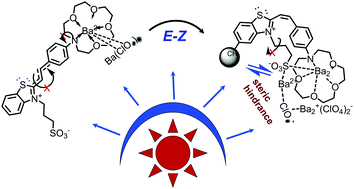Accumulation of the photonic energy of the deep-red part of the terrestrial sun irradiation by rare-earth metal-free E–Z photoisomerization†
Abstract
Large scale solar energy storage in the form of E–Z photoisomerisable organic materials requires avoidance of applying rare earth metals at any stage of the process used. Here, drastic shortening of the synthetic route of crown ether functionalized hemicyanine dyes, suitable for efficient E–Z photoisomerization under extremely low excitation light intensities compared with unconcentrated sunlight is reported. The higher energetic form was successfully stabilized by rare earth free cations – in this case by styryl dye-Ba2+ complexes. For the first time E–Z photoisomerization was demonstrated and was observed directly by excitation with light substantially red-shifted compared to the absorption spectrum of the trans-to-cis active moieties via the process of triplet–triplet annihilation upconversion.



 Please wait while we load your content...
Please wait while we load your content...